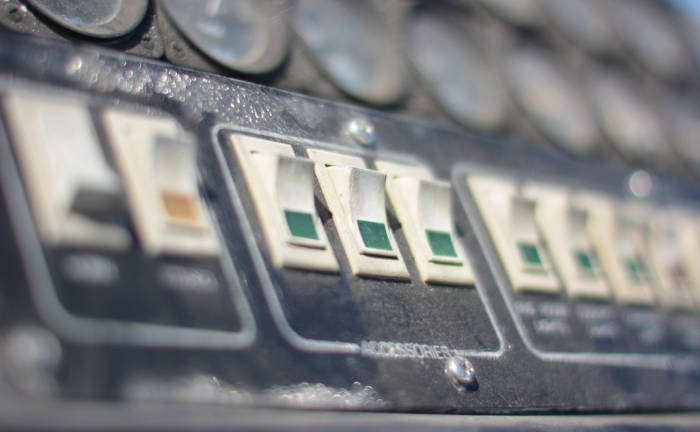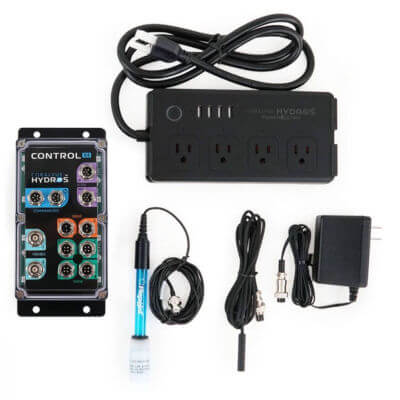Aquarium automation is the hot trend that uses electronic devices to monitor and control key functions in the aquarium.
In the past, the best you could do is turn your aquarium light on and off with a timer. Now most LED aquarium lights have built-in timers. Today aquarium controllers are far more advanced than a simple light timer.
My recommended modular controller is the Neptune APEX, keep reading for more options!
The idea behind aquarium automation is to make keeping an aquarium easier by continuously monitoring and controlling important functions and parameters. Automation helps maintain a consistent aquatic environment for fish, aquatic plants, corals and other invertebrates.

There are different types and levels of automation based on the kind of controller. The control device can be a simple temperate controller that monitors and controls one or more aquarium heaters.
Modular aquarium control systems use a main “brain” unit that stores the programs, sending commands to assorted add-on modules that perform specialized control functions.
The level of complexity and automation can be very sophisticated and involve pH, ORP, water level, lighting control, water pumps and more. Some aquarium controllers even use apps and cloud-based devices to automation and monitor just about everything that happens in the aquarium Automation .
Types of functions incorporated into an aquarium controller
- Lighting schedule
- Heating and cooling
- Water pump control
- pH
- ORP
- Oxygen
- Ammonia
- Dosing of additives
- Automatic top-off
How to choose an aquarium controller
The first step is to determine how many parameters you want to control.
Many freshwater aquarists that use carbon dioxide for their plants monitor the pH and control the CO2 dosing with a pH control device. The desired pH range is programmed into the controller.
The pH probe continuously monitors the pH. If the pH climbs too high, the controller opens the carbon dioxide solenoid valve. When the pH dips below the set point, the controller turns off the solenoid valve.
The carbon dioxide and pH level work hand in hand to stimulate plant growth and maintain a stable pH/CO2 balance.
Another single function controller is a temperature monitor and controller. Like the pH controller, a temperature controller uses a high and low set point.
If the water gets too warm, the heater is switched off and a cooling device is turned on. When the water cools, the reverse happens.
But most aquarists are interested in more advanced aquarium controllers.
These are modular devices that allow you add more control as you build the system. Many of these aquarium controllers record water quality parameters, send you alerts and allow you to control the aquarium from anywhere in the world with a smart device.
Aquarium Controllers Reviews
1. CoralVue Hydros
The CoralVue Hydros Controller system was designed to eliminate the need to use a separate control module on every piece of aquarium hardware.
Normally smart equipment like water pumps, lighting and ATOs require their own controller.
This creates a rat’s nest of power cords and cables under the aquarium. The Hydros system eliminates the need for modules, simplifying the set-up of your smart aquarium.
The control box contains all the standard connections, allowing you to connect Hydros equipment at one central location. There are sensor connections and drive ports for powering small pumps. Larger pumps and lighting are controlled through a wireless power strip.
With the Hydros app, you’ll be able to see the status of each component including voltage draw and internal temperature. The system uses the proprietary Hydrous Safety Net which ensures the control system won’t lose its programming and control. The Control Two has two sensor ports for equipment like a leak detector and water level sensor.
The Control 2 comes with a temperature sensor. It also has two Drive Ports, which power and control small devices like a fan or ATO pump.
The Control 4 is intended for reef and planted aquariums. It has connections for up to four sensors and includes a temperature and pH probe along with a Wi-Fi-enabled power strip.
Pros
- Easy to set up.
- Made in the US.
- Expandable to control multiple aquariums.
- Eliminates the need for multiple modules as you add devices.
Cons
- You can’t program lighting modes through the Hydros app.
2. Neptune Systems APEX
The Apex system combines purpose-built hardware coupled with Apex Fusion.
Apex Fusion is a cloud-based software that communicates with the hardware.
Apex Fusion monitors and controls the most important parameters in a reef aquarium.
The Apex system can be as simple or advanced as you want it to be.
 More at Amazon More at AquariumSpecialty
More at Amazon More at AquariumSpecialty
You tell Apex what to do through the wired keypad, your computer, or smart device.
Apex obeys and will report back how your aquarium is doing. If the aquarium is getting too warm Apex Fusion will send a text message alert. The Apex Fusion software will record the pH levels and create a graph illustrating the pH level over time.
You can program the water pump to shut off while the automatic feeder adds food to the aquarium.
- Automatic water changes.
- Automatic feeding of liquid and dry foods.
- Wireless control of compatible LED lighting.
- Pump and lighting control.
- Wireless control of select pumps.
- Automatic monitoring of the light level at the coral surface.
- Automatic leak detection and notification.
- pH/ORP monitoring and logging.
- Salinity testing.
- Dissolved oxygen monitoring.
- LED lunar cycle simulation.
- Control of WAV powerheads.
The base system comes with an Apex base unit, Apex display, Energy Bar 8 power strip, temperature probe and lab grade pH probe. An upgraded Apex system is also available.
Pros
- Expandable monitoring and control system.
- Many APEX pumps, probes, feeding and dosing equipment available.
- Programming and control via computer or keypad.
- Compatible with a variety of LED lights and water pumps.
- Wi-Fi capability.
Cons
- Wi-Fi system is expensive.
- Must be tech-savvy to program advanced features.
- Designed primarily for reef aquariums but can be used in freshwater tanks.
3. Inkbird Aquarium Dual Stage Temperature Controller + NTC Sensor
The Inkbird Dual-Stage Temperature Controller is designed to monitor the water temperature with a high-quality probe and maintain a stable water temperature.
The Inkbird is more than a remote aquarium heater thermostat.
The device works by automatically controlling a heater and cooling device, depending on the need.
If the aquarium water temperature starts to climb above the pre-set level, the Inkbird will turn on power to the cooling power outlet. Typically a cooling fan is plugged into this outlet.
The cooling fan blows air across the surface of the aquarium, carrying heat from the aquarium light away from the aquarium.
The Inkbird specifications show that a compressor-based chiller can be plugged into the outlet due to the 1200 watt capacity of the unit.
Pros
- The temperature sensor is stainless steel and rated “waterproof IP68”.
- Has high and low temperature alarms.
- Digital high and low temperature set point readout.
Cons
- Requires hanging on a wall or under the aquarium to view the read-out.
4. Hydor Smart Level Controller, Automatic Top Off (ATO)
Water evaporation can be quite substantial, especially in reef aquariums using bright lighting.
In some cases, water has to be added every day to compensate for evaporation.
This is especially important for reef aquariums that use a filter sump.
Evaporation causes the water level to drop dramatically in the sump due to its relatively small size compared to the aquarium.
Add in evaporation caused by intense lighting and circulation pumps and you’ll understand why water needs to be added daily.
The Hydor Smart Level Controller has a sensor that detects low and high water levels. The sensor attaches to the sump or inside the aquarium (in case you don’t use a sump).
When the water level drops the controller switches on a power outlet.
Connect a small power head to the power outlet to pump water into the aquarium. You’ll have to provide the small power head and container of water from which to draw water.
If for some reason the water level is too high, an alarm will sound. This is helpful in you happen to be filling the aquarium from a hose connected to a sink.
Pros
- Simple plug and play operation.
- Small size.
- Works with any size aquarium.
Cons
- Sensor is slow to respond when filling the aquarium.
- Occasional false alarms when a fast water pump is used.
5. American Marine PINPOINT pH Controller
The Pinpoint pH Controller uses a high-quality pH probe to continuously monitor pH in freshwater and marine aquariums.
You select the high and low set points. When either set point is reached the corresponding power outlet is switched on.
This is ideal for controlling a carbon dioxide system. When the pH is high the controller turns on the carbon dioxide system.
 More at Amazon More at AquariumSpecialty
More at Amazon More at AquariumSpecialty
It turns off the CO2 system when the pH is in the desired range. If the pH is too acidic from excess CO2, the second outlet is turned on, typically powering an air pump to drive off carbon dioxide gas.
The Pinpoint pH Controller can also be used to control the addition of “Kalkwasser” based on pH level.
The Pinpoint controller is easy to set up and use. The controller uses high-quality materials for the case, buttons, and power outlets.
Pros
- Easy to use.
- Quality build.
- Small size.
Cons
- Does not record pH levels.
- Does not have an alarm.
6. Milwaukee Instruments MC122 pH Controller
It has two pH set points. When the pH level drifts to either set point, the controller turns on a single power outlet.
 More at Amazon More at AquariumSpecialty
More at Amazon More at AquariumSpecialty
The outlet will power a small dosing pump or solenoid valve.
The calibration process is simple. Instructions are straight-forward and easy to follow.
Pros
- Industrial quality.
- Simple calibration.
- Reliable operation.
Cons
- Lacks audible alarm.
- Must be visible to see the LED alarm.
- Has only one power outlet.
7. GHL ProfiLux
GHL is a German manufacturer of high-tech aquarium automation equipment.
The company offers complete aquarium automation kits that contain everything you need to start monitoring and controlling your reef tank, planted aquarium or terrarium immediately.





